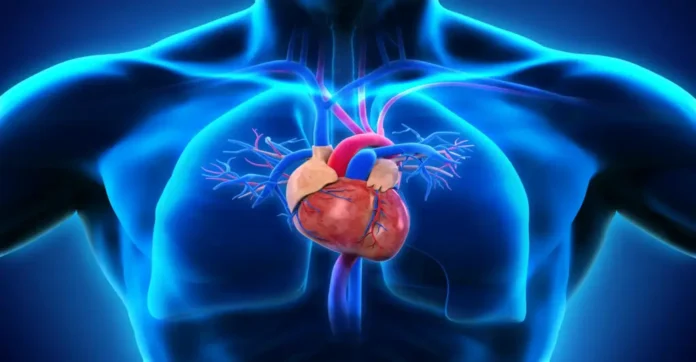World Heart Day, observed globally on September 29th annually, prompts us to ponder heart disease prevention. As a leading global cause of death, heart disease affects people across ages and backgrounds. This day underscores the significance of heart health and the need to raise awareness about prevention and healthier living.
Heart Disease: A Multifaceted Spectrum
Heart disease encompasses various conditions like coronary artery disease, heart attacks, heart failure, arrhythmias, and congenital defects. While some risk factors are beyond our control (age, family history, genetics), lifestyle choices can reduce heart disease risk.
A heart-healthy diet is paramount. Embrace fruits, vegetables, whole grains, and lean proteins, while limiting processed foods, saturated fats, and added sugars. This approach ensures vital nutrients while minimizing harmful substances.
Regular physical activity is another pillar of heart disease prevention. Just 30 minutes of moderate exercise most days improves weight, blood pressure, cholesterol, and cardiovascular health. Walking, jogging, swimming, or cycling make a difference.
Smoking significantly elevates heart disease risk. Quitting is challenging but crucial. Seek professional support, join groups, or use nicotine replacement therapies.
Stress is a contributor. Manage it with mindfulness, hobbies, socializing, or professional help when needed.
Regular check-ups and screenings detect and prevent heart disease. Monitor blood pressure, cholesterol, and blood sugar for early intervention.
World Heart Day unites us to combat heart disease. Educate, promote healthier living, and support those affected.
Heart disease prevention is lifelong. Small, consistent lifestyle changes protect hearts and well-being. Reflect and act on this World Heart Day. Prevention is key.
What is heart disease?
Heart disease, a comprehensive term encompassing a diverse array of conditions affecting the heart’s structure and function, stands as the primary cause of global mortality, claiming over 18 million lives annually.
Numerous heart diseases exist, with the most prevalent including:
- Coronary Artery Disease (CAD): CAD entails the narrowing or blockage of coronary arteries, responsible for supplying blood to the heart muscle. CAD can culminate in a heart attack when the heart’s blood supply becomes obstructed.
- Heart Failure: Heart failure arises when the heart lacks the strength to efficiently pump blood, stemming from factors such as CAD, high blood pressure, or diabetes.
- Arrhythmia: Arrhythmias denote abnormal heart rhythms, which, while some are benign, can be life-threatening in certain forms.
- Congenital Heart Defects: These congenital anomalies impact the heart’s structure and function. While some are benign, others necessitate surgical intervention.
Heart disease can be caused by various factors, including:
- Lifestyle Influences: Smoking, high blood pressure, elevated cholesterol, and obesity rank as prominent risk factors for heart disease.
- Genetic Predisposition: Genetics makes some individuals more susceptible to heart disease.
- Age: Advancing age escalates the risk of heart disease.
- Coexisting Medical Conditions: Conditions such as diabetes and kidney disease can heighten the likelihood of heart disease.
Symptoms of Heart Disease
Heart disease’s symptomatology varies according to the specific condition. Some common symptoms of heart disease include:
- Chest Discomfort
- Breathlessness
- Fatigue
- Palpitations (sensation of rapid or irregular heartbeat)
- Edema in the feet and ankles
Prompt medical attention is imperative if these symptoms manifest.
Management and Treatment of Heart Disease
Management and treatment of heart disease adopt a multifaceted approach, contingent on the condition’s nature and severity. Treatment modalities encompass:
- Lifestyle Modifications: Initiating changes such as smoking cessation, adopting a balanced diet, regular exercise, and maintaining a healthy weight can deter and manage heart disease.
- Medications: Various drugs, including those that reduce blood pressure, cholesterol, and blood sugar levels, serve as crucial tools in heart disease management.
- Surgical Interventions: Surgical procedures such as coronary artery bypass grafting (CABG) for unblocking coronary arteries or repairing or replacing damaged heart valves may be necessary in certain cases.
Preventive measures are paramount to shielding oneself from heart disease. By embracing a healthy lifestyle and effectively managing underlying medical conditions, individuals can curtail their susceptibility to heart disease.
Multifaceted Spectrum of Heart Disease
The term ‘expansive spectrum’ aptly characterizes the manifold manifestations of heart health problems. Its reach extends across ages, genders, and races, and its symptoms and severity exhibit wide-ranging diversity.
Heart disease’s multifaceted nature also permeates its causes and treatments. An amalgamation of factors contributes to the disease, and personalized treatment regimens are indispensable for optimal outcomes.
Encouragingly, substantial preventive and management measures exist for heart disease. By embracing healthy living and collaborating with healthcare professionals, individuals afflicted with heart disease can enjoy fulfilling, extended lives.
Expansive Spectrum of Heart Disease
Consider the following facets of heart disease’s expansive spectrum:
- Age: Heart disease can affect individuals of all ages, with the risk increasing as one grows older.
- Gender: Although men face a higher risk, women are not exempt from heart disease.
- Race: Certain racial groups, such as African Americans, encounter a greater predisposition to heart disease.
- Symptoms: The symptomatology of heart disease varies based on type and severity, featuring common signs like chest discomfort, breathlessness, fatigue, palpitations, and lower extremity edema.
- Causes: Diverse factors, including lifestyle choices (e.g., smoking, hypertension, obesity), genetic predisposition, and coexisting medical conditions (e.g., diabetes, kidney disease), contribute to heart disease.
- Treatment: Individualized treatment strategies are vital since there is no universal remedy for heart disease. Treatment options span lifestyle alterations, pharmaceuticals, and surgical interventions.
The multifaceted nature of heart disease may pose diagnostic and therapeutic challenges. Nevertheless, with a comprehensive understanding and a personalized approach, effective management and mitigation of its impact are achievable.
World Heart Day: Protecting Our Hearts
Annually on September 29th, World Heart Day reminds us of cardiovascular disease (CVD), the leading global cause of death. CVD encompasses heart disease, stroke, and related conditions.
This day prompts reflection on heart disease prevention, emphasizing its preventable nature. To reduce risk:
- Adopt a Heart-Healthy Diet: Prioritize foods low in saturated fats, trans fats, cholesterol, and sodium, while embracing fruits, vegetables, and whole grains.
- Exercise Regularly: Aim for at least 30 minutes of moderate-intensity exercise most days.
- Maintain a Healthy Weight: Excess weight strains the heart.
- Quit Smoking: Smoking significantly raises heart disease and stroke risk.
- Control blood pressure, cholesterol, and blood sugar: Elevated levels can harm the heart and blood vessels.
Regular checkups and screenings are essential for early intervention.
Safeguard Your Heart on this World Heart Day
On World Heart Day, pledge to safeguard your heart:
- Plan a healthy week of meals.
- Enjoy a post-dinner walk or bike ride.
- Schedule a doctor’s checkup.
- Discuss smoking cessation with your doctor.
- Support heart health charities through volunteering or donations.
By nurturing our hearts, we extend and enhance our lives.
Additional insights on heart disease prevention:
- Start Early: Early adoption of heart-healthy choices yields lasting benefits.
- Gradual Changes: Focus on one or two changes at a time, solidifying habits before moving on to the next.
- Build a Support System: Engage friends or family in the journey of your healthy choice.
- Persistence: Embrace setbacks as part of the process; restart when needed.
Your heart is your lifeline; cherish it, and it will reciprocate with longevity and vitality.
Diet’s Role in Nourishing Heart Health
Maintaining cardiovascular well-being hinges on adopting a heart-healthy diet. Such a diet should be abundant in fruits, vegetables, whole grains, and lean proteins while keeping processed foods, saturated fats, and added sugars to a minimum. This approach ensures your body receives essential nutrients while minimizing detrimental substances that could harm your heart.
Why is a heart-healthy diet important?
Heart disease stands as the primary global cause of mortality. Its root lies in the accumulation of arterial plaque, which can impede oxygen-rich blood flow to the heart and result in heart attacks or strokes.
A heart-healthy diet plays a pivotal role in diminishing your risk of heart disease by:
- Reducing cholesterol levels.
- Lowering blood pressure.
- Enhancing blood sugar management
- Mitigating inflammation.
What foods should I eat for a heart-healthy diet?
To cultivate a heart-healthy diet, consider these guidelines:
Embrace an abundance of fruits and vegetables. These foods are low in calories and teeming with nutrients, including fibre, vitamins, and minerals. They also serve as potent sources of antioxidants, guarding your heart against damage.
Favour whole grains over refined grains. Whole grains offer higher fibre content along with more vitamins and minerals compared to refined grains. Fibre contributes to reduced cholesterol levels and better blood sugar control.
Opt for lean proteins over processed meats. Choices like fish, poultry, beans, and tofu are lean in saturated fat and calories, unlike processed meats such as bacon, sausage, and hot dogs, which are laden with saturated fat and sodium.
Restrict your consumption of processed foods, saturated fats, and added sugars. Processed foods often contain unhealthy fats, excessive sugar, and salt. Saturated fats and added sugars can elevate cholesterol levels and heighten your risk of heart disease.
How to Get Started with Your Heart-Healthy Journey
Even small dietary adjustments can yield substantial benefits for your heart health. Begin with these strategies:
- Increase your daily fruit and vegetable intake to a minimum of five servings.
- Prioritize whole grains over refined options whenever possible.
- Opt for grilling, baking, or roasting your food instead of frying.
- Curtail your consumption of processed meats, sugary beverages, and unhealthy fats.
Should you have inquiries or apprehensions regarding dietary alterations, do not hesitate to consult your physician or a registered dietitian.
Role of Regular Physical Activity in Preventing Heart Disease
Engaging in regular physical activity serves as a cornerstone in the prevention of heart disease. It empowers individuals to manage and lose weight, regulate blood pressure, enhance cholesterol levels, and promote overall cardiovascular well-being.
A mere 30 minutes of moderate exercise on most days can yield significant benefits. Such activities may encompass walking, jogging, swimming, or cycling.
Physical Activity for Heart Health
Let’s delve into the specific advantages of physical activity for cardiovascular health:
- Weight Management: Physical activity facilitates calorie burning and supports the maintenance of a healthy weight. Given that obesity stands as a major heart disease risk factor, weight control assumes paramount importance in cardiovascular health.
- Blood Pressure Regulation: Physical activity contributes to the reduction of blood pressure levels, thereby mitigating another critical risk factor for heart disease.
- Cholesterol Levels: Engaging in physical activity can lead to improvements in cholesterol profiles. Elevated cholesterol levels can result in arterial plaque buildup, which narrows arteries and heightens the risk of heart attacks and strokes.
- Overall Cardiovascular Health: Physical activity fortifies the heart muscle, enhances circulation, minimizes inflammation, and bolsters blood sugar management.
For those embarking on an exercise journey, it is advisable to slowly and progressively amplify the intensity and duration of workouts as you build your fitness. Identifying enjoyable activities that align with your lifestyle is pivotal.
Before initiating any new exercise regimen, particularly if you have underlying health conditions, it is imperative to consult with your healthcare provider.
Smoking Cessation: A Guide to Breaking Free
Embarking on the journey to stop smoking is undoubtedly a profound decision in favour of your well-being. This endeavour promises enhanced respiratory vitality, a diminished susceptibility to malignancies and assorted maladies, and considerable monetary relief. However, the path to cessation is riddled with complexities, and relapses often lurk in the shadows.
Navigating this labyrinth requires a meticulous understanding of perplexity and burstiness within your strategy. In essence, perplexity is the intricate nature of your plan, while burstiness represents the diversity of approaches at your disposal.
Human authors adeptly infuse their narratives with varying sentence lengths, fostering burstiness, a nuance often lacking in AI-generated prose, which tends to maintain a monotonous cadence. To craft content that befits your goals, keep this distinction in mind.
Another key facet of crafting compelling content is the lexicon at your disposal. Where artificial intelligence opts for conventional verbiage, humans opt for the unconventional. Leveraging less common terminology adds a layer of uniqueness and authenticity to your composition.
Smoking Cessation: Strategies to Quit
Now, let’s explore the labyrinth of smoking cessation strategies:
- Choose a quit date and stick to it. Embark on your smoke-free journey by selecting a definitive quit date within the ensuing fortnight. This time frame provides the opportunity for meticulous preparation, including the eradication of all tobacco paraphernalia from your life.
- Tell your friends and family that you are quitting. Do not tread this path alone. Share your resolution with your close-knit circle. Their camaraderie and encouragement will be your pillars of strength when the going gets tough.
- Identify your triggers. Delve deep into your psyche to identify the stimuli that beckon the urge to smoke. Armed with this knowledge, devise strategies to either circumvent these triggers or effectively cope with them in a wholesome manner.
- Develop healthy coping mechanisms. Quitting smoking often unleashes stress and cravings. To navigate this turbulent sea, it is imperative to foster healthy coping mechanisms. Consider immersing yourself in physical exertion, embracing relaxation techniques, or basking in the warmth of cherished relationships.
- Consider using nicotine replacement therapy (NRT). The aid of NRT products, encompassing patches, gum, and lozenges, can significantly alleviate withdrawal symptoms and cravings, facilitating your journey to liberation from tobacco’s grip.
- Seek professional help if you need it. If the labyrinth proves too intricate to navigate alone, do not hesitate to enlist the support of seasoned quit-smoking programs and counsellors. They will assist in architecting a cessation blueprint tailored to your unique journey.
Additional Smoke-Quitting Strategies
Here are some additional strategies that can help you quit smoking:
- Avoid your triggers: If you recognize individuals, locales, or circumstances that stoke your smoking desires, diligently evade them.
- Distract yourself: When cravings come knocking, divert your attention to alternative pursuits, whether it be a stroll, a heart-to-heart conversation with a confidant, or a bout of gum-chewing.
- Celebrate Milestones: Each milestone achieved in your smoke-free expedition warrants celebration. These rewards serve as potent motivators along your path to triumph.
It is crucial to acknowledge that the road to quitting smoking is fraught with challenges. However, armed with these strategies, you can significantly augment your likelihood of success. Remember, each smoke-free day is a testament to your body’s remarkable capacity for healing and rejuvenation.
Stress Management: A Key to Heart Health
Chronic stress can take a toll on your heart health. It has the ability to raise both your blood pressure and heart rate, casting a shadow over your cardiovascular health. Furthermore, it triggers the release of stress hormones, which, in turn, may inflict harm on your precious arteries. However, there are preventive measures that you can embrace to manage stress and safeguard your heart health.
Here are a few tips:
Below are some invaluable recommendations to embark on this journey of stress management and heart health preservation:
- Recognize stress as a risk factor for heart disease. It is of paramount significance to recognize stress as a formidable risk factor for heart disease. By embracing this awareness, you lay the foundation for a proactive approach to health. When the tendrils of stress encircle you, invest the time to discern its origins, subsequently forging strategies to counter its effects.
- Practice mindfulness: Mindfulness, a practice characterized by unwavering attention to the present moment devoid of judgment, emerges as a powerful tool in your arsenal against stress and anxiety. Multiple avenues exist for its cultivation, spanning the realms of meditation and yoga or simply dedicating a few moments each day to the rhythmic cadence of your breath.
- Make time for hobbies and social interaction. Cultivating moments of joy and human connection stands as a potent antidote to stress. Carve out precious intervals for activities that kindle your inner delight and tranquillity. This may encompass cherished hours spent in the company of loved ones, the solace of a compelling book, or the enchantment of soul-stirring melodies.
- Seek the Guidance of Experts: Should the tempest of stress prove overpowering, do not hesitate to enlist the expertise of professionals. Therapists, equipped with a reservoir of coping strategies, can guide you through the labyrinth of stress management, and together, you can architect a bespoke plan tailored to your unique needs.
It is pivotal to engrave in your consciousness that stress management is an indispensable pillar of heart health. By diligently implementing these strategies, you not only fortify your defences against heart disease but also chart a course towards enhanced overall well-being. The legacy of your endeavours shall be a heart fortified and resilient, capable of withstanding the vicissitudes of time and stress.
Regular Check-Ups: The Key to Heart Disease Prevention
Early detection of heart disease is essential for effective treatment and prevention. Regular health assessments and screenings can help identify risk factors and underlying conditions before they cause serious damage.
During a check-up, your cardiovascular doctor will typically measure your blood pressure, cholesterol, and blood sugar levels. These are all key indicators of cardiac (heart) health. If any of these levels are elevated, your healthcare provider can work with you to develop a plan to manage them and reduce your risk of heart disease.
Apart from reviewing your risk factors and medical history, your cardiac doctor may also perform a physical examination and order additional blood tests, such as an electrocardiogram (EKG) or echocardiogram. These diagnostic procedures are instrumental in identifying cardiac disorders like coronary artery disease, congestive heart failure, and arrhythmias.
Early detection of heart disease is important because it allows for earlier intervention and better outcomes. For instance, if you are diagnosed with high blood pressure early on, you may be able to manage it through lifestyle changes such as diet and exercise. However, if high blood pressure or hypertension is left untreated, it can damage your heart and arteries, leading to more serious heart and cardiac conditions.
If you are at risk for heart disease, it is important to talk to your cardiac doctor about how often you should get health check-ups and screenings. The American Heart Association recommends that adults get regular cardiac health check-ups starting at age 20. The frequency of check-ups will depend on your individual risk factors and medical history.
Advantages of regular check-ups and screenings for heart disease
Here are some of the benefits of regular check-ups and screenings for heart and cardiac disease:
- Early detection of heart conditions and risk factors
- More effective treatment and prevention
- Reduced risk of serious heart events, such as heart attack and stroke
- Improved overall health and well-being
If you have any concerns about your heart health, talk to your cardiac doctor. They can help you develop a plan to stay healthy and reduce your risk of heart disease.
World Heart Day: A Call to Action to Unify for Heart Health
World Heart Day, celebrated annually on September 29th, serves as a rallying point for individuals, communities, and organizations to unite in the fight against heart disease. Through education, promotion of healthier living, and support for those affected, we can make a collective impact in reducing the burden of this global epidemic.
Heart Disease Prevention: A Lifelong Journey
Prevention is key to a heart-healthy future. Making consistent, small changes to our lifestyles, such as eating a healthy diet, exercising regularly, and managing stress, can have a profound impact on our heart health. World Heart Day is an opportunity to reflect on our current habits and make a commitment to our heart health, both today and for years to come.
Protecting Our Hearts from Cardiovascular Diseases
Cardiovascular disease (CVD) is the leading cause of death worldwide, encompassing heart disease, stroke, and related conditions. However, the good news is that up to 80% of CVD is preventable. By raising awareness of the risk factors for CVD and promoting heart-healthy behaviours, we can help protect our hearts and build healthier communities.
World Heart Day: A Time to Reflect and Take Action
This World Heart Day, let’s unite to raise awareness of heart disease and promote heart-healthy living. Together, we can make a difference in the fight against this global killer.
Here are some specific things you can do to celebrate World Heart Day and take action to safeguard your heart health:
- Learn more about heart disease, its risk factors, and how to prevent it.
- Talk to your doctor about your heart health and get regular checkups.
- Make healthy choices for yourself, such as eating a healthy diet, exercising regularly, and managing stress.
- Support organizations that are working to combat heart disease and promote heart health.
- Spread the word about World Heart Day and encourage others to take action for their heart health.
Together, we can create a world where everyone has the opportunity to live a heart-healthy life.














